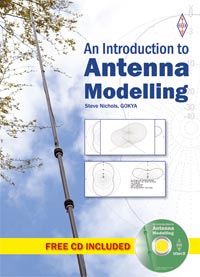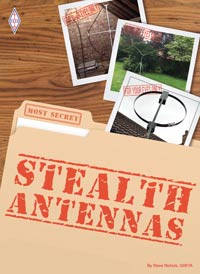 |
The circuit diagram - you can easily make this on
a piece of PCB. |
This has to be the
ultimate in small antennas – one that will receive everything from
VLF to HF (even VHF) in a package less than six inches long!
The antenna was
conceived after Roelof, PA0RDT, had several attempts to make an
active loop work in a city environment.
What he discovered
was that the electric field from local noise sources was generally
contained within his house. But, the magnetic field of noise sources
was not, making weak signal reception at LF virtually impossible.
From that he decided
that an antenna mounted outdoors that was receptive to the electric
field rather than the magnetic field might be useful.
After extensive
tests he said it became clear that at LF an active whip is
effectively a “capacitance coupled to the electric field”.
Roelof added that in
practice the “whip” can be tiny, such as a small piece of copper
clad printed circuit board. Hence his Miniwhip was born. Roelof's
practical design is only 100mm long and 40mm in diameter yet will
receive from 10 kHz – 30 MHz.
It is an active
antenna and that feeds the power to the antenna via the coax and a
bias T circuit.
The antenna details
and schematic are available on the internet for you to make one, but
Roelof also makes them to order (you can email him at
roelof@ndb.demon.nl).
At the time of writing the cost was €48 including shipping within
Europe.
The antenna and its
amplifier circuit are built into a sealed grey plastic pipe leaving
you only to connect a suitable length of coax via its BNC socket. You
will need to provide a 9-15V supply, such as a small “wall wart”
PSU. But it must be a “clean” supply as some of these can be
electrically noisy.
Extensive tests with
the antenna showed that it is very prone to receiving noise (which I
had been warned about). In my shack it picked up all manner of
interference, from switch mode power supplies to a low-energy light
bulb. Even a TV on standby in a room 20ft away caused problems. To be
fair, this was to be expected. Roelof says it is an excellent noise
sniffer! He has used it extensively to investigate several local
noise sources.
It is best mounted
outdoors and as high as you can get it. In fact, I mounted mine on a
telescopic fibreglass pole so that I could test it at different
heights up to 8m.
 |
| The tiny commercial version, direct from Roelof. |
Extensive use of
ferrite chokes might also be useful. I found that my two PCs produced
a lot of interference, which was picked up on my Perseus SDR
receiver. Using my Icom 756 Pro 3 with the PCs switched off made a
big different, especially on the LF/MF bands. Roelof says that
grounding the shield of the coax before it enters the house or at the
bottom of the mast is also important.
What happens is that
local noise is received on the shield of the coax inside the house
and travels to the antenna. By grounding the shield, the noise will
"flow" to earth. This can make a considerable difference.
He has also included a RF isolating transformer in the power bias T
box. A jumper is used to select between isolated and connected
grounds.
What also soon
became apparent was that the higher I mounted it, the better the
Miniwhip worked. In fact, at about 5m it almost matched the
performance of my existing HF antennas, despite its tiny size.
Roelof says that
moving the antenna from 1.2m to 4.8m could increase the received
signal strength by up to 8dB on the lower bands and I would agree.
I tested it on
everything from non-directional beacons (NDBs at LF), long wave,
medium wave and all ham and broadcast frequencies up to 30MHz and it
worked very well indeed.
Mounted on a
fibreglass pole the antenna merrily received aircraft non-directional
beacons down in the 300kHz range – signals that were considerably
weaker on my main doublet antenna.
It was a similar
story with medium wave stations, with the tiny antenna pulling in
stations from all over Europe in August. My usual test is to see how
well I can pick up BBC Radio Wales on 882kHz from Washford, Somerset,
here in Norfolk. It did this with flying colours.
Moving up to Top
Band (160m) and there wasn't a lot of activity, but I did pick up
some DL and PA CW signals that were at least as loud as those
received on my W5GI antenna over the roof.
It was similar
performance on 80m (3.5MHz) where the little antenna worked
reasonable well, but was down on a dedicated 80m antenna. Noise
levels were a lot lower though. On 40m (7MHz) the antenna also picked
up signals, but the signal levels were down quite significantly.
Interestingly, in some instances, the overall signal to noise ratio
was no different, so in terms of copying the signals there was little
difference.
 |
My own version built (very) ugly style and now
mounted in a piece of 40mm PVC pipe. |
Roelof says that he
has his mounted at 4m on a non-conductive mast to get clear of bushes
in his garden, but he has also had excellent results in an open field
at a height of only two metres.
The Miniwhip makes
an excellent SWL antenna, as long as you spend some time calming all
the various noise sources in your shack.
I even mounted it in
the loft, where it worked, but again noise levels were higher.
In the interests of
experimentation I also decided to build one myself from the plans I
found on the internet.
The antenna is made
on a piece of single-sided PCB, with the top half acting as the
antenna and the lower half holding the circuit. I made my circuit
board by carefully cutting away the copper with a Dremel-type tool. I
then built the circuitry “ugly-style” (very ugly actually!) onto
the board, using Superglue to mount some of the components securely
with their wire leads being used for the interconnections. The end
result was a little Heath Robinson, but did it work? The answer was a
resounding yes.
As a test I also
tried it on VHF and found it was a reasonably effective little
antenna for airband and 2m signals.
Overall then, if you
have no means of putting up an antenna for Top Band, and are also
interested in LF, NDBs and medium wave, this tiny antenna will let
you listen to all the action.













